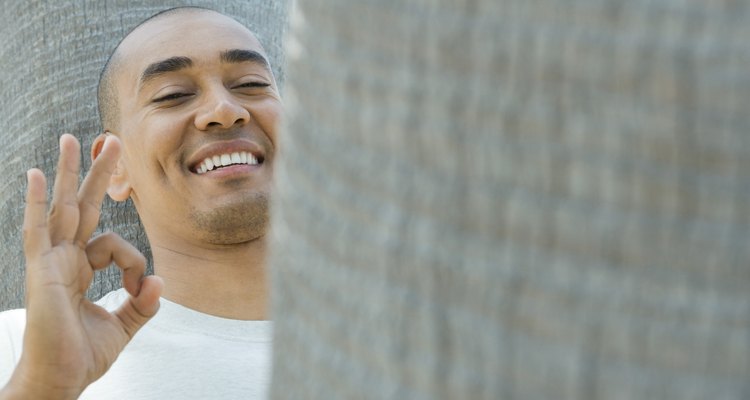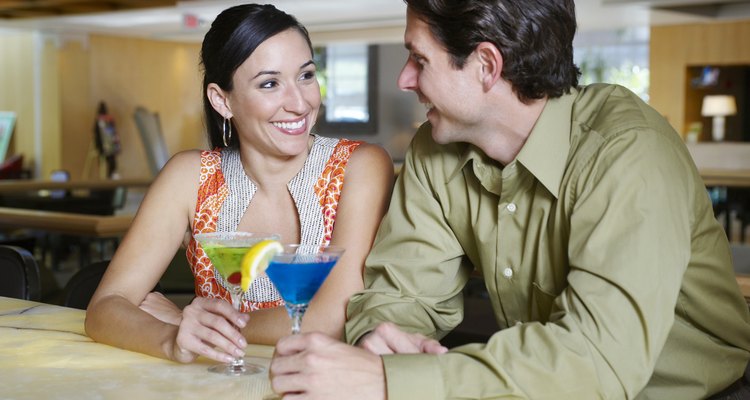
Photick/Photick/Getty Images
Communication stretches far beyond the spoken word. You can learn a great deal from someone based on what he isn't saying at all. Information regarding interests and emotions are often gleaned through the use of gestures and other types of body language. In fact, nonverbal communication is the most honest kind, according to social and personality psychologist Jeremy Nicholson in his article for Psychology Today entitled, "Reading Basic Body Language for Dating and Persuasion Success." Understanding the meanings behind these movements can help you connect with a man in your life and navigate your relationship with him as well.
Head and Face

DAJ/amana images/Getty Images
A training manual developed at Moreno Valley College and titled, "Body Language Basics" clarifies the meanings behind some of the most common actions of the head and face. If someone is nodding and making eye contact, for instance, he is expressing interest. A shaking head is a gesture of disagreement. A head tilt is a sign of vulnerability, which signals trust. If his head is held high, with chin up, however, he may be feeling superior and overly confident.
Arms and Hands

Photick/Sigrid Olsson/Photick/Getty Images
Movements of the arms and hands can also be quite telling. A pointing finger often indicates aggression. Gestures that can be interpreted as positive include initiated or reciprocated physical contact, such as a squeeze of the arm or shoulder, hand-holding or a hug. Negativity is signaled by crossing arms, leaning or turning away, stiffness and minimal eye contact, according to Nicholson. Men are more likely than women to fidget, but this need not mean that they are hostile or impatient. It is believed to simply be a way of burning energy, according to "Body Language Basics."
Legs and Feet

moodboard/moodboard/Getty Images
A man's legs and feet may not be the most commonly used body language tools, but paying attention to them may still be informative. While in a sitting position, he may cross his legs purely for the sake of comfort, or as a way of separating or distancing himself from you. As with all types of body language, this should be considered in conjunction with other cues to accurately perceive what he is communicating. Whether sitting or standing, feet usually point in the direction of interest. If they are pointing toward you, this is a good sign. If they are pointing toward the door or his car, he may feel compelled to leave.
Posture and Space

moodboard/moodboard/Getty Images
Facial expressions and movements of the head and limbs are not the only means of communicating non-verbally. A man's posture and use of space tell what he is thinking and feeling too. Standing or sitting straight communicates confidence, as highlighted in "Body Language Basics." Aside from the influences of illness or injury, hunching over is a sign of insecurity. Men also tend to have wide stances so they appear larger -- they even take up more space than women when sitting. This is likely due more to learned gender norms than sending particular signals.
Related Articles

How to Know When a Man Is Distancing ...

Male Gestures That Indicate He Is ...

Understanding Male Body Language

How to Ask Someone If They Are Cheating ...

Different Forms of Cheating in a ...

How to Read a Man's Facial Expressions

How to Read Body Language for Love ...

Characteristics of Face-to-Face ...

What Is the Meaning of Judgmental?

The Ten Commandments of Human Relations

Living With a Clingy Husband

How to Stop Finding Fault

Barriers to Effective Verbal ...

Excessive Jealousy & Possessiveness

Signs That a Married Man Might Like You

How to Fix a Relationship After Cheating

How to Communicate With My Husband ...

How to Recognize the Signs of a Man's ...

Differences in Listening Between a Man ...

How to Be Emotionally Supportive of a ...
References
Writer Bio
Jill Avery-Stoss is a graduate of Penn State University and a writer and editor based in northeast Pennsylvania. Having spent more than a decade working with victims of sexual and domestic violence, she specializes in writing about women's issues, with emphasis on families and relationships.
Photo Credits
Photick/Photick/Getty Images